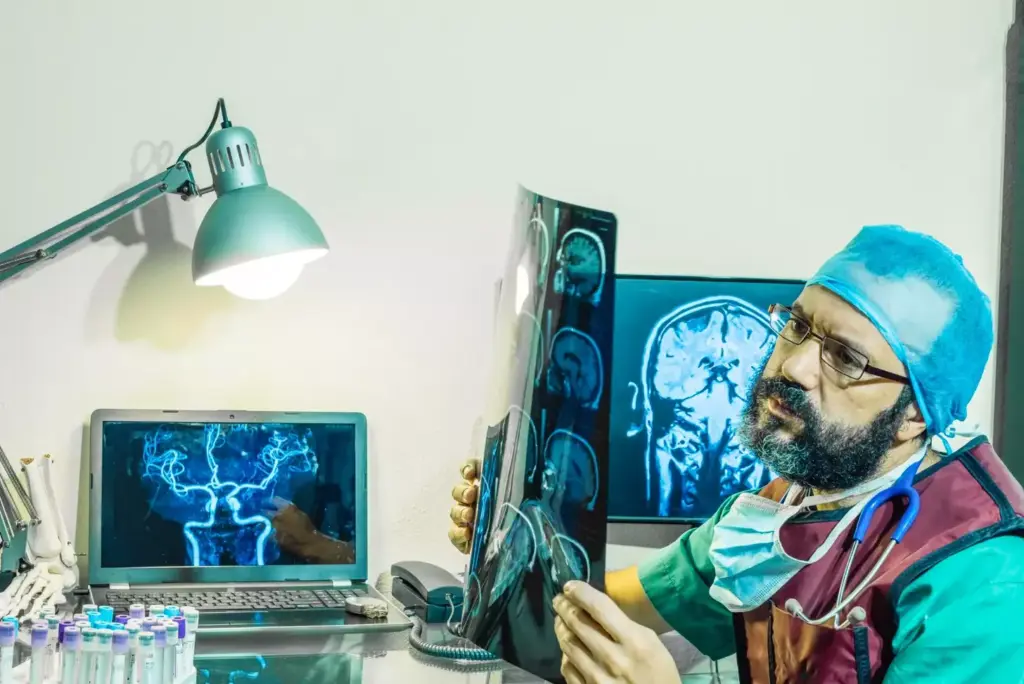Last Updated on November 27, 2025 by Bilal Hasdemir

Treating brain tumors needs precise and advanced neurosurgical procedures. At Liv Hospital, we use the latest techniques for the best results in brain tumor surgery. Our team focuses on personalized care, using the newest medical science to make brain mass removal surgery safer and more effective.
Many neurosurgical procedures are used, depending on the tumor. These include craniotomy, endoscopic brain surgery, keyhole procedures, and stereotactic radiosurgery. These new methods have changed how we treat brain tumors, giving hope to those with tumors that were once thought untreatable.
Key Takeaways
- Advanced neurosurgical procedures improve outcomes for brain tumor patients.
- Liv Hospital employs cutting-edge techniques for safer brain mass removal.
- Personalized care is a cornerstone of our neurosurgical services.
- Various surgical methods are used based on tumor characteristics.
- Innovative techniques offer new hope for inoperable brain tumor cases.
The Critical Role of Surgical Intervention in Brain Tumor Treatment
Surgery is key in treating brain tumors, giving hope to those facing these serious conditions. Brain tumors vary greatly, each needing its own treatment plan.
It’s important to know the type of tumor you have. Tumors are either malignant or benign.
Types of Brain Tumors: Malignant vs. Benign
Malignant tumors grow fast and can spread. They can start in the brain or come from other parts of the body. Benign tumors grow slower and are not cancerous. Yet, they can cause problems because of where they are.
Knowing if a tumor is malignant or benign helps doctors decide how to treat it. This includes whether surgery is needed.
When Surgical Removal Becomes Necessary
Surgery is needed when a tumor is a big risk to a patient’s health. This could be because of where it is, how big it is, or the symptoms it causes. Surgery might be an option for both types of tumors, based on several factors.
We consider surgery if a tumor is causing serious symptoms or could cause problems later. Deciding on surgery involves a thorough check-up and talking about the possible outcomes and risks.
The Evolution of Brain Mass Removal Surgery Techniques
The journey of brain mass removal surgery is filled with innovation. It’s driven by new medical tech and our growing knowledge of the brain. Over time, neurosurgery has changed a lot, making treatments safer and more successful.
Historical Approaches to Neurosurgery
Early neurosurgery was basic and often risky. One of the first brain surgeries was trephining, where holes were drilled into the skull. This early method helped start the path to today’s neurosurgery.
In the late 19th and early 20th centuries, neurosurgery became a real medical field. Harvey Cushing introduced better surgical methods, improving results for patients. His work on stopping bleeding and using special tools was a big step forward.
Technological Advancements Transforming Brain Tumor Surgery
New tech has changed brain tumor surgery a lot. Tools like MRI and CT scans help find tumors accurately. This lets surgeons focus their efforts better.
New tools and methods have also come along. Laser Interstitial Thermal Therapy (LITT) and Stereotactic Radiosurgery (SRS) are new ways to fight brain tumors. They’re less invasive, leading to quicker healing and fewer problems.
| Technological Advancement | Description | Impact on Brain Tumor Surgery |
|---|---|---|
| Advanced Diagnostic Imaging | Precise localization of tumors using MRI and CT scans | More targeted surgical approaches, improved patient outcomes |
| Intraoperative MRI | Real-time assessment of tumor removal during surgery | Maximal resection of tumors while preserving brain structures |
| Laser Interstitial Thermal Therapy (LITT) | Minimally invasive laser ablation of tumors | Alternative to open surgery, reduced recovery time |
The future of treating brain tumors looks bright. It will blend technology, skill, and care for the patient. With these advances, we can give patients better, safer treatments.
Pre-Surgical Evaluation and Planning Process
The journey to remove a brain tumor starts with a detailed pre-surgical evaluation. This phase is key to gathering all needed info. It helps us plan the safest and most effective surgery for each patient.
Advanced Diagnostic Imaging Techniques
Advanced imaging is vital in the pre-surgery process. We use top-notch imaging like MRI and CT scans. These scans give us clear images of the brain tumor.
Determining Surgical Candidacy and Approach
After getting the images, we check the patient’s health to see if they can have surgery. We look at their medical history and current health. We also consider the tumor’s size and location.
Comprehensive Risk Assessment Protocols
Understanding risks is a big part of the pre-surgery process. We identify possible risks like neurological problems or complications. Knowing these risks helps us plan to avoid them and improve the patient’s outcome.
This careful planning makes brain tumor surgery safer and more effective. It leads to better results for patients.
Technique 1: Traditional Craniotomy for Brain Mass Removal
Traditional craniotomy is a key method for removing brain masses. It has been improved over years and is important in neurosurgery.
Step-by-Step Procedure Overview
First, we give the patient general anesthesia for comfort. Then, we make an incision in the scalp. Next, we remove a part of the skull, called a bone flap.
This lets us access the brain to remove the tumor. After removing the tumor, we put the bone flap back and secure it. We then close the scalp incision.
The surgery needs careful planning and precision. We use advanced imaging and monitoring to avoid harming the brain.
Ideal Candidates and Tumor Types
Traditional craniotomy works for many brain tumors. The choice depends on the tumor’s size, location, and how accessible it is. Patients with large or complex tumors are good candidates.
This method is great for tumors in hard-to-reach places. It allows for direct removal of the tumor.
Recovery Timeline and Possible Complications
The recovery time varies based on the patient and surgery. Patients usually stay in the hospital for a few days. They need to manage pain, prevent infection, and watch for any changes in their brain function.
While safe, complications like infection, bleeding, and brain problems can happen. We try to avoid these by planning carefully and being precise.
With the right care, most patients can get back to normal in a few weeks or months. We give detailed instructions and support for a smooth recovery.
Technique 2: Minimally Invasive Keyhole Surgery
Keyhole surgery uses small cuts to remove brain tumors. This method is less invasive than traditional surgery. It’s a big step forward in neurosurgery for some patients.
Procedural Mechanics of Keyhole Approaches
Keyhole surgery makes a small hole in the skull, less than an inch. This minimally invasive approach helps avoid damage to the brain. It’s a new way to remove tumors safely.
Surgeons use advanced imaging like intraoperative MRI for precise tumor removal. Special tools and endoscopes help them work through the small hole.
Comparative Benefits Over Traditional Craniotomy
Keyhole surgery has many advantages over traditional craniotomy:
- Less tissue damage and pain after surgery
- Smaller scars
- Shorter hospital stays and quicker recovery
- Lower risk of infections and complications
A study in a neurosurgery journal found keyhole surgery reduces complications. Patients do better than those with traditional craniotomy.
“The advent of keyhole surgery has marked a significant shift in our approach to brain tumor treatment, allowing us to achieve better outcomes with less morbidity.”
Patient Selection Criteria and Limitations
Not every patient is right for keyhole surgery. The choice depends on:
- Tumor size and location
- Tumor type and how aggressive it is
- Patient’s health and medical history
Keyhole surgery is great, but it’s not for everyone. Larger or more complex tumors might need traditional surgery. Our neurosurgeons carefully choose the best surgery for each patient.
Technique 3: Endoscopic Brain Tumor Removal
Endoscopic brain tumor removal is changing neurosurgery. It’s a new way to remove tumors without big surgeries. This method uses special tools to see and take out tumors through small cuts. It cuts down on risks and helps patients heal faster.
Advanced Endoscopic Equipment and Techniques
The success of this method depends on the tools used. Today’s endoscopes have high-definition cameras and special tools for precise tumor removal. Some key techniques include:
- High-Definition Visualization: Gives clear images of the tumor and around it.
- Angled Endoscopes: Helps surgeons reach tumors in tricky spots.
- Specialized Instruments: Made for careful tumor removal.
Optimal Tumor Locations for Endoscopic Approach
Not every brain tumor can be removed this way. The best candidates are tumors in places that can be reached easily. Tumors in these areas are often good for endoscopic surgery:
- Pituitary gland
- Ventricular system
- Skull base
Clinical Outcomes and Recovery Advantages
Endoscopic brain tumor removal has many benefits. It leads to less pain, shorter hospital stays, and quicker recovery. The small cuts also mean less damage to the brain, which can lower the chance of lasting problems. Research shows that patients often see:
- Faster Recovery: Thanks to smaller cuts and less damage.
- Reduced Complications: Fewer risks of infection and other problems after surgery.
- Improved Cosmetic Outcomes: Less scarring because of the small cuts.
As technology gets better, endoscopic brain tumor removal will likely help more patients. It offers hope to those with tumors that were once thought too hard to treat.
Technique 4: Transsphenoidal Surgery for Pituitary Tumors
The transsphenoidal approach is a special surgery for pituitary tumors. It’s great for reaching deep tumors without a big cut in the skull. Surgeons use the sphenoid sinus to get to the pituitary gland, causing less damage.
Accessing Deep Brain Structures Through Natural Corridors
For this surgery, a small cut or an endoscope goes through the nose. Then, surgeons go to the sella turcica to find the tumor. This way, they can remove the tumor safely, without harming nearby brain areas.
Specialized Applications for Sellar and Parasellar Masses
This method is best for tumors in the sellar and parasellar areas. It lets surgeons safely remove tumors near important structures. This is done with high precision.
Endocrine Considerations and Post-Operative Management
Dealing with pituitary tumors means watching hormone levels closely. We adjust treatments to keep hormones balanced. After surgery, we check on the patient’s healing and manage any issues. We also keep an eye out for any tumor growth or hormonal problems in the long run.
Technique 5: Stereotactic Radiosurgery for Non-Invasive Tumor Treatment
Stereotactic radiosurgery is a key non-invasive treatment for brain tumors. It uses advanced tech to target tumors with precision, reducing harm to healthy tissue.
Gamma Knife and CyberKnife Technologies Explained
Gamma Knife and CyberKnife are top technologies in this field. Gamma Knife uses cobalt to send gamma radiation to tumors. CyberKnife uses a linear accelerator to create beams of radiation. Both are precise and treat many brain tumors.
A study in the Journal of Neurosurgery found Gamma Knife radiosurgery effective. It controls brain tumors well with little risk of complications.
“The precision of Gamma Knife radiosurgery allows for the delivery of high doses of radiation to the tumor while sparing surrounding normal brain tissue.”
| Technology | Radiation Source | Tumor Types Treated |
|---|---|---|
| Gamma Knife | Cobalt source | Benign and malignant tumors |
| CyberKnife | Linear accelerator | Various brain tumors, including metastases |
Single-Session vs. Fractionated Treatment Protocols
Stereotactic radiosurgery can be done in one session or spread over several. The choice depends on the tumor’s size, location, and the patient’s health. Smaller tumors often get single-session treatments, while bigger ones might need fractionated ones.
Fractionated treatment protocols can give higher doses of radiation. This might help some patients more. But, it means more visits, which can be hard for some patients.
Long-Term Efficacy and Follow-Up Requirements
The long-term success of stereotactic radiosurgery is important. Studies show Gamma Knife and CyberKnife can control tumors well for a long time. Regular check-ups are key to catch any problems early.
Having a detailed follow-up plan is vital. This includes regular scans and doctor visits. It helps ensure the best results for patients.
Technique 6: Laser Interstitial Thermal Therapy (LITT)
Laser Interstitial Thermal Therapy (LITT) is changing how we treat brain tumors. It’s a new way to remove tumors using laser energy. This method is great for tumors that are hard to reach or can’t be removed by usual surgery.
MRI-Guided Precision Targeting Methodology
LITT uses MRI to guide the laser to the tumor. A laser catheter is inserted into the tumor under MRI watch. This lets us see the tumor and brain details clearly, making sure the laser hits the right spot.
Key benefits of MRI-guided LITT include:
- Enhanced precision in targeting tumors
- Reduced risk of damage to surrounding brain tissue
- Real-time monitoring of the ablation process
Real-Time Thermal Monitoring During Ablation
LITT can watch the tumor’s temperature in real-time. This is done with MRI thermometry, giving us instant feedback. We can adjust the laser to kill the tumor without harming nearby brain.
Applications for Deep-Seated and Previously Inoperable Tumors
LITT is great for deep or hard-to-reach brain tumors. It’s also good for tumors in important brain areas. Its precision and watchful eye make it a good choice for patients who can’t have regular surgery.
| Tumor Characteristics | LITT Suitability | Benefits |
|---|---|---|
| Deep-seated tumors | High | Minimally invasive, precise targeting |
| Tumors in eloquent brain areas | High | Real-time monitoring, reduced risk of functional damage |
| Previously inoperable tumors | High | Offers a treatment option where none existed before |
Technique 7: Awake Brain Surgery with Functional Mapping
Awake brain surgery with functional mapping is a top-notch neurosurgical method. It lets us remove brain tumors carefully, keeping important brain functions safe. This method has greatly helped patients with tumors in key brain areas.
Patient Selection and Preparation Protocols
Choosing the right patient for awake brain surgery is key. We look at the tumor’s size, location, and the patient’s health. A team of experts, including neurosurgeons and anesthesiologists, plan the surgery together.
“The key to successful awake brain surgery lies in meticulous planning and a thorough understanding of the patient’s neurological status,” says a renowned neurosurgeon.
Intraoperative Brain Mapping Techniques
During surgery, we use brain mapping to find and keep safe important brain spots. We use electrical impulses to test the brain while the patient is awake. This helps us make a detailed map of the brain’s functions.
A study in the Journal of Neurosurgery says, “Intraoperative mapping is key for removing tumors safely and keeping brain functions intact.”
Preserving Critical Brain Functions During Tumor Resection
The main goal of awake brain surgery is to remove tumors while keeping brain functions intact. We watch the patient’s responses closely during surgery. This way, we can avoid harming important areas.
This method not only helps patients live longer but also improves their quality of life after surgery.
As neurosurgery advances, awake brain surgery with functional mapping will be more important. It combines the latest technology with skilled surgery. This gives hope to patients with tough diagnoses.
Innovative Approaches for Previously Inoperable Brain Masses
The field of brain tumor treatment is changing fast. New methods are giving hope to those with masses that were once thought untreatable. Thanks to advances in technology, treatments are becoming more tailored and effective.
Combination Therapy Strategies for Complex Cases
Combination therapy is showing promise for complex brain tumors. It combines surgery, radiation, and chemotherapy in a way that works best for each patient. This approach can lead to better control of the tumor and a better outlook for patients.
One key part of combination therapy is making treatment fit each patient’s needs. For example, neoadjuvant chemotherapy can shrink tumors before surgery. Then, adjuvant radiation therapy after surgery can kill any remaining cancer cells, lowering the chance of the tumor coming back.
| Therapy Combination | Benefits | Typical Applications |
|---|---|---|
| Surgery + Radiation | Improved local control, reduced recurrence risk | High-grade gliomas, meningiomas |
| Chemotherapy + Surgery | Tumor shrinkage, improved surgical outcomes | Large or inoperable tumors |
| Radiation + Chemotherapy | Enhanced tumor killing, improved survival | Aggressive or recurrent tumors |
Staged Surgical Approaches for High-Risk Tumors
For high-risk tumors, staged surgical approaches are used. This method breaks down surgery into steps. It makes removing the tumor safer and more controlled.
Staged surgery is great for tumors near important brain areas. It lets us watch the patient’s brain function closely. We can adjust the surgery as needed to keep risks low.
Tumor Debulking When Complete Removal Isn’t Possible
When removing a brain tumor completely isn’t possible, tumor debulking is an option. It involves removing as much of the tumor as we can. This helps ease symptoms and improve life quality.
Tumor debulking can also help with pressure in the brain and symptoms. It might make other treatments like radiation or chemotherapy work better.
These new methods give patients with tough brain tumors more hope. They offer better chances for a good outcome and a better life.
Post-Surgical Care and Rehabilitation Following Brain Mass Removal Surgery
Brain mass removal surgery is just the start. After surgery, careful care is key for a good recovery. A team of experts works together to meet each patient’s needs.
Immediate Post-Operative Management
Right after surgery, patients stay in a special ward. The medical team keeps a close eye on them. They manage pain, prevent infections, and watch for any brain problems.
Important parts of early care include:
- Checking the brain often to see if anything has changed
- Using medicines and other methods to control pain
- Stopping blood clots and other serious problems
Neurological Rehabilitation Strategies
When patients get better, rehab starts. A team of experts helps create a plan just for them. This plan focuses on what they need and want to achieve.
Rehab might include:
- Physical therapy to get stronger and move better
- Occupational therapy to learn daily tasks again
- Speech therapy for those having trouble speaking or swallowing
Long-Term Surveillance and Follow-Up Protocols
Keeping an eye on patients long-term is very important. This helps catch any problems early. A special plan is made for each patient, which might include regular tests and check-ups.
Important parts of long-term care include:
- Scans to check for tumor growth
- Brain checks to see how well patients are doing
- Tests for hormone issues in some patients
With detailed care and rehab, we help our patients get the best results. This improves their life after brain surgery.
Conclusion: Advancing the Future of Brain Tumor Treatment
Neurosurgery has made big strides in treating brain tumors, giving hope to people all over the world. We’ve looked at different surgical methods. These range from traditional craniotomy to new techniques like laser interstitial thermal therapy and awake brain surgery.
The future of neurosurgery is looking good. Research and new ideas are making care and treatment better for brain tumor patients. Now, surgeries for non malignant and benign tumors are more precise and effective. This means less recovery time and better results for patients.
We’re excited about the future of treating brain tumors. Our goal is to provide top-notch healthcare to everyone, including international patients. We want to make sure they get the best treatment for their needs.
The outlook for neurosurgery is bright. We’re eager to see more progress in the field. This will lead to even better results for patients with brain tumors.
FAQ
What is brain mass removal surgery?
Brain mass removal surgery, also known as brain tumor surgery, is a neurosurgical procedure. It aims to remove a tumor or mass from the brain. We use different techniques based on the tumor’s type, location, and the patient’s health.
What are the different types of brain tumors that can be treated with surgery?
We treat both malignant and benign brain tumors with surgery. The type and characteristics of the tumor decide if surgery is needed. Our team carefully evaluates each case to choose the best treatment.
How has brain mass removal surgery evolved over time?
Brain mass removal surgery has seen big changes, from traditional craniotomy to newer methods like keyhole surgery and endoscopic removal. New technologies have improved outcomes and opened up more treatment options.
What is the pre-surgical evaluation process for brain mass removal surgery?
Our pre-surgical evaluation includes advanced imaging and risk assessment. We check if surgery is right for the patient. This detailed evaluation helps us plan the best surgical approach.
What is a craniotomy, and when is it used?
A craniotomy is a traditional surgical method. We temporarily remove a part of the skull to access the brain. It’s used for certain patients and tumor types, and it’s effective for removing brain tumors.
What is keyhole surgery, and how does it differ from craniotomy?
Keyhole surgery is a minimally invasive technique with smaller incisions and less tissue disruption. We choose patients for this method based on specific criteria. It’s a less invasive option for some patients.
Can you explain endoscopic brain tumor removal?
Endoscopic brain tumor removal uses advanced equipment for tumor removal through small incisions. It’s suitable for certain tumor locations. This technique offers benefits like faster recovery.
How is transsphenoidal surgery used for pituitary tumors?
Transsphenoidal surgery accesses deep brain structures through natural corridors. It allows us to remove pituitary tumors. This method requires specialized techniques and careful endocrine considerations.
What is stereotactic radiosurgery, and how is it used?
Stereotactic radiosurgery is a non-invasive treatment using Gamma Knife or CyberKnife technologies. It targets brain tumors with precision. We use it for specific cases, requiring careful planning and follow-up.
Can you explain Laser Interstitial Thermal Therapy (LITT)?
LITT is a minimally invasive technique using MRI-guided precision targeting. It treats deep-seated or previously inoperable tumors. We use real-time thermal monitoring for safety and efficacy.
What is awake brain surgery with functional mapping?
Awake brain surgery is performed while the patient is awake. It uses functional mapping to preserve brain functions. We carefully select patients for this technique, aiming to remove tumors while minimizing neurological deficits.
What are the post-surgical care and rehabilitation requirements after brain mass removal surgery?
Our post-surgical care includes immediate management, neurological rehabilitation, and long-term follow-up. A multidisciplinary approach ensures complete care and support for our patients.
Can brain tumors be completely removed with surgery?
The goal of brain mass removal surgery is to remove as much of the tumor as possible. The extent of removal varies based on the tumor’s characteristics, location, and the patient’s health. In some cases, we may use combination therapy or staged surgical approaches.
Are there any risks or complications associated with brain mass removal surgery?
Like any surgery, brain mass removal surgery carries risks and complications. We evaluate each patient’s risk factors and take steps to minimize complications.
How can I determine if I am a candidate for brain mass removal surgery?
We evaluate each patient individually, considering their health, tumor characteristics, and other factors. If you have a brain tumor, our team will discuss your treatment options, including surgery. We help determine the best course of treatment for you.








